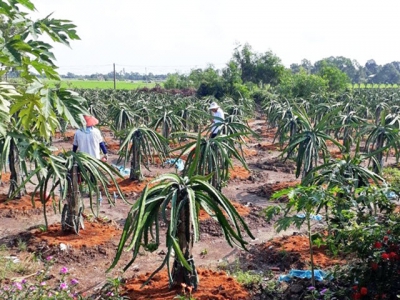Long An: Only about 5% of dragon fruits exported to Europe

Currently, due to the dependence on the Chinese market, dragon fruit prices are unstable and greatly affect the application of high technology; farmers are not interested in joining cooperatives. Many farmers petitioned Long An Provincial People's Committee to strengthen trade promotion and find new output markets for dragon fruits.
Many farmers petitioned Long An Provincial People's Committee to strengthen trade promotion and find new output markets for dragon fruits
The area of growing dragon fruit in the province is about 10,595 hectares, the productivity is about 31 tons per hectare and the output is 253,269 tons. Dragon fruit is grown mainly in Chau Thanh district and neighboring districts (Tan Tru, Thu Thua districts and Tan An city, ...). In addition, many other localities in the province also grow dragon fruit.
The whole province has about 154 cooperatives; cooperative groups; enterprise, and so on.
Dragon fruit is mainly exported to China (about 80 percent of production), consumption in the domestic market is 15 percent, export to Europe by official quota is 5 percent.
Implementing Resolution 08-NQ/TU on June 16, 2016 of the Provincial Party Committee, Long An Provincial People's Committee issued the Project on developing high-tech application agriculture associated with the restructuring of the Agriculture sector.
According to the target of the project, by 2020, the area of dragon fruits applying high technology in Chau Thanh district will be 2,000 hectares. Up to now, the district has grown 2,078 hectares out of 2,000 hectares, reaching 104% of the plan. Functional departments of the province have supported 24 cooperatives and cooperative groups of dragon fruit production areas to apply high technology to achieve VietGAP certification; the area is 595 hectares, more than 909 households participated in the project area.

Farmers apply high technology in planting dragon fruit
In recent years, the provincial departments and branches have supported many businesses and cooperatives to promote exports and connect consumption through the Dragon Fruit Association of Long An.
In order to export dragon fruits to the Chinese market, the authorities of Long An province also registered and granted the planting area codes for 54 communes in 4 districts (Chau Thanh, Tan Tru, Thu Thua and Thanh Hoa) and Tan An city; the code of export packing establishment for dragon fruit to more than 80 enterprises, cooperatives, etc.
According to the provincial People's Committee, in order to find the output for agricultural products in general and dragon fruit in particular, enterprises, cooperatives and cooperative groups should actively coordinate with the management agencies. There are few cooperatives and cooperative groups participating in trade promotion because the funding to support trade promotion activities is still limited.
Some businesses and cooperatives have not really paid attention to participating in fairs and conferences to connect supply and demand; not actively signed the contract after joining the connection activity or even delayed providing relevant documents when requested by the partners.
In the coming time, Long An Provincial People's Committee will continue to coordinate with the Food Safety Management Board of Ho Chi Minh City to strengthen trade promotion to promote dragon fruit products in major provinces and cities such as Hanoi, Ho Chi Minh City and some neighboring provinces; invite domestic and foreign enterprises to invest in building factories processing raw materials from dragon fruits; support cooperatives, cooperative groups and businesses to participate in trade fairs, especially participating in the Conference on promoting agricultural consumption in Lang Son province; hold a dialogue conference between businesses, cooperatives and cooperative groups in the area of high-tech dragon fruit production; find new markets for dragon fruits, especially EU, Japan, US and Australia markets.
Related news
 China to import more rice from Cambodia
China to import more rice from Cambodia Chinese authorities have agreed to speed up the review of applications of 40 Cambodian firms that want to export rice to the Chinese market
 Land policies restrain Vietnam’s agricultural development
Land policies restrain Vietnam’s agricultural development Scattered, small-sized land lots hamper farmers and stop companies from investing in agriculture, while barriers set by land accumulation policies
 Ninh Thuận farmers grow more foreign grape varieties
Ninh Thuận farmers grow more foreign grape varieties The south-central province of Ninh Thuận, the country’s largest grape producer, is expanding cultivation of high-quality foreign grape varieties.